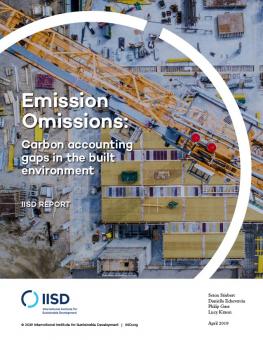
Emission Omissions: Carbon accounting gaps in the built environment
Life-cycle assessment (LCA) studies are the best tool we have to measure the carbon footprints of building products at each phase of their lifespan, but they have some flaws.
Life-cycle assessment (LCA) studies are the main tool used to measure the carbon footprints of building products at each phase of their cradle-to-grave lifespan (i.e., production, use and end of life).
With over 30 per cent of greenhouse gasses (GHGs) in Canada coming from the communities and structures we build for ourselves, accurately measuring building materials' carbon footprints is key to crafting meaningful policy—from building codes to product preference—to meet carbon reduction targets. There is a clear need for us to get this right.
While LCAs are the best-available tool for evaluating the GHG (and other) performance of alternative building products and designs, policy-makers and building designers should be aware there are also limitations, challenges and uncertainties that must be considered.
Media Release: Tool for tracking GHGs in Canada’s buildings has “built in” errors: study
Emission Omissions: Carbon Accounting Gaps in the Built Environment delves into those uncertainties. The report considers:
- Limitations, challenges and uncertainties in existing LCAs, quantifying their significance to the current understanding of the relative GHG performance of buildings made alternatively of concrete, steel or wood structural elements.
- Best practices that could improve the reliability and usefulness of LCA to support effective policies to decarbonize the built environment.
- Longer-term opportunities to reduce life-cycle emissions in the built environment by supporting decarbonization efforts in the concrete, steel and forestry sectors.
The report includes three key recommendations to policy-makers looking to reduce carbon in the building sector:
- Building efficiency and longevity should be the priority for decarbonizing the built environment.
- LCA is the right approach, but more data, transparency and robust standards are needed, especially with respect to biogenic carbon.
- To address embodied GHG emissions in buildings, policy-makers and building professionals need to focus equally on material efficiency and incenting decarbonization across all material manufacturing sectors.
The report was guided and peer reviewed by a diverse Advisory Committee of:
- Keith Brooks, Environmental Defence
- Trevor Hesselink, CPAWS
- Dr. Jay Malcolm, Faculty of Forestry, University of Toronto
- Jamie Meil, Athena Sustainable Materials Institute
- Jean-François Ménard, International Reference Centre for the Life Cycle of Products
- Heidi Nesbitt, Local Practice Architecture + Design
- Dr. Jeff Wells, Boreal Song Bird Initiative
- Scott Demark, BuildGreen Solutions
Participating experts
You might also be interested in
IISD Applauds Canada’s Reaffirmation to End Domestic Public Finance for Fossil Fuels in Budget 2024
Today's federal budget announcement delivers new measures to support affordability and reaffirms Canada’s commitments on climate action.
The Critical Next Step: What you need to know about Canada’s 2030 climate target
Canada's climate target for 2030 is within reach, but more stringent policies and clearer government communication will be needed to get there. Our expert explains why these developments are critical for Canada to help avoid the worst impacts of climate change.
Ottawa supports Big Oil over the climate
One can only imagine the positive buzz these days inside the boardrooms of Canada's oil companies, as they rake in record profits and plan major expansions of their oil production. Amid all the good cheer, one could easily lose sight of the fact that those plans will push the world dangerously closer to the brink of irreversible climate chaos. Even as the world finally signed a commitment at UN climate talks last month to begin transitioning away from fossil fuels, Canada's major oil companies are poised to do exactly the opposite — to greatly expand their fossil fuel production.
Feds and province veto offshore oil exploration in Nova Scotia
A licence to explore the offshore of Nova Scotia for oil and gas and restart fossil fuel activity there after years of dormancy was rejected Monday by the federal and provincial governments. The decision to reject the licence considers broader policy focused on "shared commitments to advance clean energy and pursue economic opportunities in the clean energy sector, which are beyond the scope of the board's regulatory purview," a joint statement said.